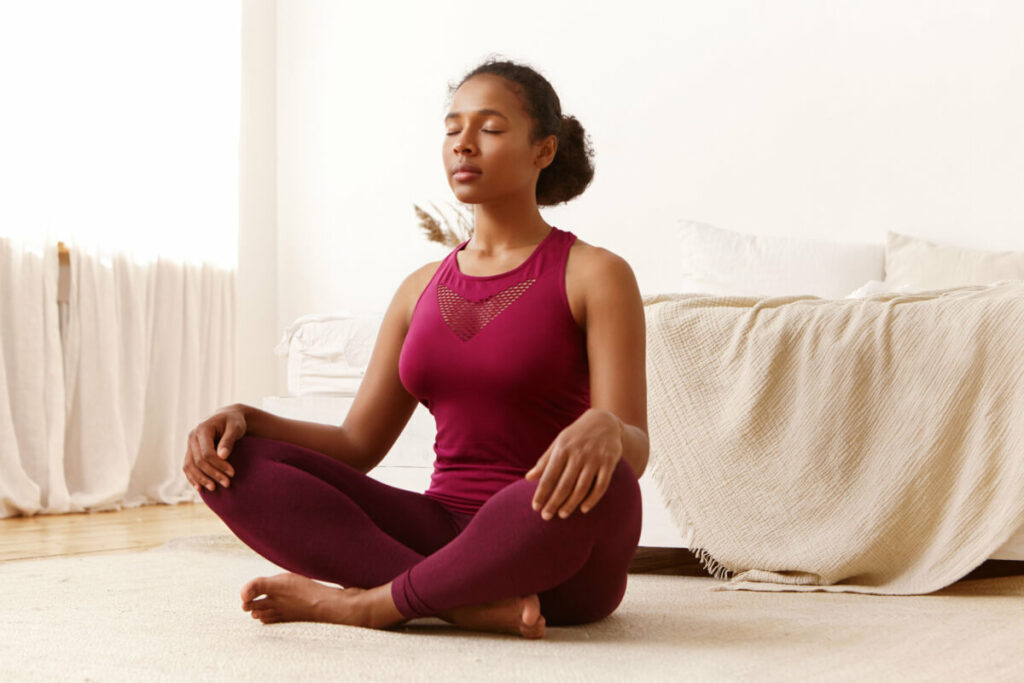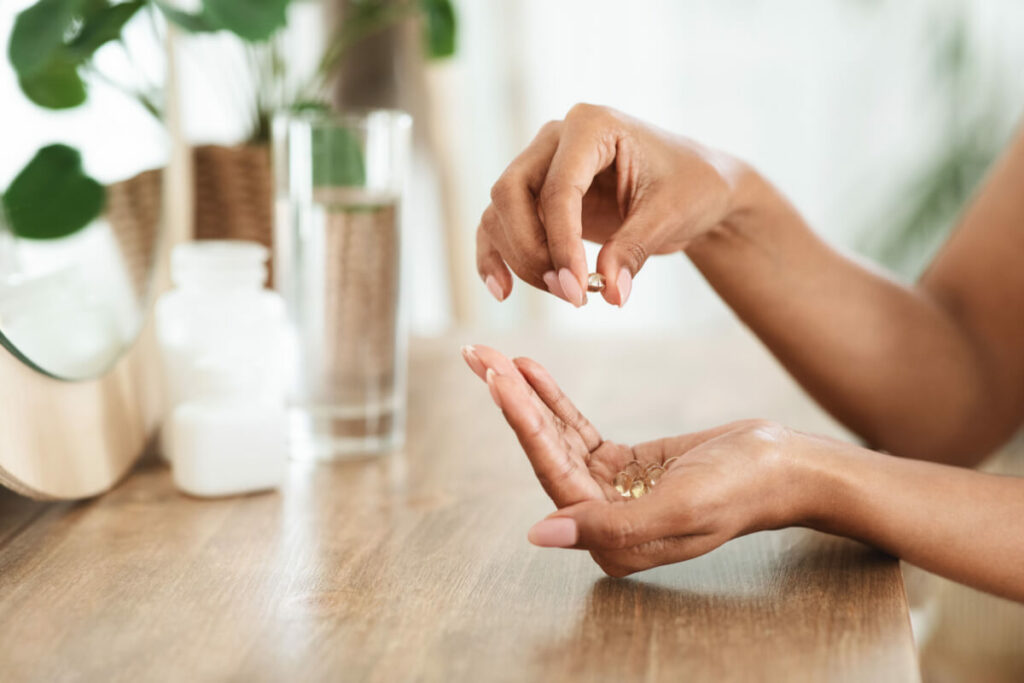Ever wonder if there are any natural remedies to support menstrual pain? Studies have shown that implementing changes to your diet and lifestyle may have a significant impact on how you feel during the menstrual period. Cramps or menstrual pain, referred to as dysmenorrhea, is pain that is experienced during a person’s menstrual period when the muscles in the uterus contract and relax while shedding its lining. (7)
Menstrual pain is the main cause of missed work and school for those of childbearing age. As a result, researchers have been studying natural approaches to pain relief and have remedies for menstrual pain showing promising results. (5)
In this article, we’ll talk about what causes menstrual pain, natural remedies for menstrual pain including foods that help with cramps, and how to reduce period pain at home with supplementation and lifestyle changes.
What is pain during the menstrual period?
Every menstruating person’s period can be slightly different, from flow to physical effects on the body such as hormonal changes or menstrual pain. Menstrual pain, clinically referred to as dysmenorrhea, is when moderate to severe pain is felt due to muscle contractions of the uterus during menstruation. This pain can be felt not only as cramps in the lower abdomen but as lower back and leg pain. (7)
Although menstrual pain is common and often considered “normal,” that doesn’t necessarily have to be the case!
What causes period pain?
Roughly 45 to 95% of people who menstruate experience dysmenorrhea, while up to 20% may have such severe pain that they are unable to engage in their usual daily activities. (16)(17) In the past, many tests and studies linked pain during the menstrual period to psychological problems such as anxiety, depression, and negative feelings towards having their period. (16)
However, recent research suggests that pain during the menstrual cycle may be due to higher levels of prostaglandins released during the shedding of the uterine lining. (16)
How to reduce period pain at home
You may not feel like leaving the house and being social while on your period, and studies have shown that this may not necessarily be a bad thing! Limiting stress at home through relaxation and other techniques, like meditation or a warm bath, may help reduce period-associated pain. (7)
A recent study has shown the effectiveness of heat in alleviating the pain associated with menstruation. Applying heat topically to areas of pain such as the lower abdomen and lower back may be just as effective as taking ibuprofen for relieving pain. (7) Along with the use of heat, performing exercises such as jogging or brisk walking can help reduce the symptoms of dysmenorrhea. (7)
Research has also shown that limiting stress and focusing on relaxation during menstruation can have a positive impact on period cramps. (7) Studies have shown that there may be an association between stress and menstrual irregularities, such as cramps. Although researchers have not been able to establish whether or not stress increases pain, limiting daily stress could be helpful. (19)

5 foods that help relieve menstrual cramps
We all know that eating healthy foods nourishes our bodies. But did you know that certain changes to your diet may help with menstrual cramps? According to research, nutrition can have a significant role in the frequency and severity of period cramps. (1)
While eating sugary or salty snacks may feel comforting when you are on your period, research shows that these types of snacks may aggravate pain associated with menstruating. Conversely, reducing intake of sweets, salty snacks, and fruit juices high in sugar while on your period may have a positive impact on pain. (12)
Research has also shown potential beneficial effects on menstrual pain of common herbs and spices you may already have in your kitchen. The following are a few spices that have shown to be promising for reducing the pain associated with cramps.
1. Cinnamon
Not only delicious, cinnamon may be able to lend a helping hand when experiencing period cramps. While cinnamon has been shown to reduce the severity of period cramps, it has also been shown to reduce the length of time that people experience pain during their cycle. (8)

2. Chamomile
Often thought of as a sleepy-time tea, chamomile may have more benefits than just being a soothing cup of tea at the end of a long day. Along with its delicious taste, the chamomile herb contains antispasmodic properties that may help reduce painful menstrual cramps caused by the uterus contracting. Its relaxing and anti-inflammatory properties can also help provide calming and relaxing effects throughout the menstrual cycle. (9)
3. Fennel seed
Known for its licorice taste, fennel may be another useful herb to relieve pain associated with menstruating. Research has demonstrated positive effects on period cramps associated with consuming fennel seed and extract. (11) Within one study, 80% of participants who received the Fennel instead of the placebo reported complete pain relief. Along with pain relief, some studies have shown that fennel extract contains trace amounts of coumarins which may speed up the clotting process and reduce menstrual bleeding. (11)
Did you know? Placebo is a substance given to a patient that doesn’t include provide any medical effects. (15)
4. Ginger
Ginger has long been a popular root used as a spice in many cuisines, but it also has an array of health benefits such as reducing nausea and vomiting. (10) Along with its many benefits, ginger has also been shown to be effective in reducing period cramps. (2) Some studies even suggest that ginger may be as effective as ibuprofen in reducing the pain of dysmenorrhea. (14)
5. Dill
Ever thought that a delicious herb could be one of the foods that help with cramps? Recent studies have shown that consuming dill just before and during the start of menstruation may be an effective way to reduce the severity of pain during menstruation. (6)
5 supplements for menstrual pain
Studies have shown that several nutrients may help reduce the pain associated with menstruation.

1. Thiamine
Thiamine, also known as vitamin B1, plays a critical role in our bodies by helping our cells grow, develop, and function optimally. (13) One recent study showed that when patients with dysmenorrhea, supplemented with thiamine they experienced a reduction in menstrual pain. (16)
2. Vitamin B6
Studies have shown that vitamin B6 may be an option for supplementation that may reduce period pain. Research has shown that Vitamin B6 has had a positive correlation with reducing period pain. (18)
3. Magnesium
A systematic review (a review of studies) showed that magnesium was more effective than placebo in reducing the pain associated with the menstrual cycle. However, the exact amount of magnesium needed to experience these effects is still unclear. (18)
4. Omega-3 fatty acids
Fish oil, or omega-3 fatty acids, is another supplement that may reduce the pain associated with cramps and support a healthy menstrual cycle. Research has shown that supplementing with fish oil or omega-3 fatty acids can have a positive impact on reducing cramps. (18)
5. Vitamin D
Low vitamin D levels have been shown to be connected to menstrual problems such as dysmenorrhea. (3) One study evaluated the impact of vitamin D on adolescent girls experiencing various menstrual problems, including period cramps. Adolescents who took high doses of vitamin D showed a reduction in cramps along with back pain. (4)
Lifestyle and other natural remedies for menstrual pain
Although there may not be a quick fix for period pains, or a way to reduce menstrual pain instantly, studies have shown that there may be some natural remedies for menstrual pain that may be worth a shot! (16) Along with exercise, acupuncture, and yoga have shown to also be effective in relieving period cramps. (16)(20)
Acupuncture, which has been used widely for pain management, may also help address period pain due to its ability to excite our nerves and block pain impulses. (16)
Yoga may also decrease dysmenorrhea. In one study, females that took part in a yoga intervention reported a reduction in their pain and other symptoms as a result of menstruation. (20)
The bottom line
Although we may not have all the answers on how to reduce menstrual pain instantly, simple changes to diet and lifestyle may help alleviate these symptoms. Menstruation is a normal part of a woman’s life, but pain doesn’t have to be.
Practicing relaxation, eating nourishing foods, and including key supplements into your routine when advised by your healthcare provider—are some potential natural remedies for menstrual pain that can help you feel your best throughout your menstrual cycle.
- Abadi Bavil, D., Dolatian, M., Mahmoodi, Z., & Akbarzadeh Baghban, A. (2018). A comparison of physical activity and nutrition in young women with and without primary dysmenorrhea. F1000Research, 7, 59.
- Adib Rad, H., Basirat, Z., Bakouei, F., Moghadamnia, A. A., Khafri, S., Farhadi Kotenaei, Z., Nikpour, M., & Kazemi, S. (2018). Effect of Ginger and Novafen on menstrual pain: A cross-over trial. Taiwanese Journal of Obstetrics and Gynecology, 57(6), 806–809.
- Arabnezhad, L., Mohammadifard, M., Rahmani, L., Majidi, Z., Ferns, G. A., & Bahrami, A. (2022). Effects of curcumin supplementation on vitamin D levels in women with premenstrual syndrome and dysmenorrhea: a randomized controlled study. BMC Complementary Medicine and Therapies, 22(1).
- Bahrami, A., Avan, A., Sadeghnia, H. R., Esmaeili, H., Tayefi, M., Ghasemi, F., Nejati Salehkhani, F., Arabpour-Dahoue, M., Rastgar-Moghadam, A., Ferns, G. A., Bahrami-Taghanaki, H., & Ghayour-Mobarhan, M. (2018). High dose vitamin D supplementation can improve menstrual problems, dysmenorrhea, and premenstrual syndrome in adolescents. Gynecological Endocrinology, 34(8), 659–663.
- Chen, C. X., Kwekkeboom, K. L., & Ward, S. E. (2016). Beliefs About Dysmenorrhea and Their Relationship to Self-Management. Research in nursing & health, 39(4), 263–276.
- Heidarifar, R., Mehran, N., Heidari, A., Tehran, H. A., Koohbor, M., & Mansourabad, M. K. (2014). Effect of Dill (Anethum graveolens) on the severity of primary dysmenorrhea in compared with mefenamic acid: A randomized, double-blind trial. Journal of research in medical sciences: the official journal of Isfahan University of Medical Sciences, 19(4), 326–330.
- InformedHealth.org . Cologne, Germany: Institute for Quality and Efficiency in Health Care (IQWiG); 2006-. Period pain: Overview. 2008 Feb 22 . https://www.ncbi.nlm.nih.gov/books/NBK279324/
- Jaafarpour, M., Hatefi, M., Najafi, F., Khajavikhan, J., & Khani, A. (2015). The Effect of Cinnamon on Menstrual Bleeding and Systemic Symptoms With Primary Dysmenorrhea. Iranian Red Crescent Medical Journal, 17(4). https://doi.org/10.5812/ircmj.17(4)2015.27032
- Khalesi, Z. B., Beiranvand, S. P., & Bokaie, M. (2019). Efficacy of Chamomile in the Treatment of Premenstrual Syndrome: A Systematic Review. Journal of Pharmacopuncture, 22(4), 204–209. https://doi.org/10.3831/kpi.2019.22.028
- Li, H., Liu, Y., Luo, D., Ma, Y., Zhang, J., Li, M., Yao, L., Shi, X., Liu, X., & Yang, K. (2019). Ginger for health care: An overview of systematic reviews. Complementary Therapies in Medicine, 45, 114–123. https://doi.org/10.1016/j.ctim.2019.06.002
- Modaress Nejad, V. & Asadipour, M. (2006). Comparison of the effectiveness of fennel and mefenamic acid on pain intensity in dysmenorrhoea. EMHJ – Eastern Mediterranean Health Journal, 12 (3-4), 423-427, 2006 https://apps.who.int/iris/handle/10665/117102
- Najafi, N., Khalkhali, H., Moghaddam Tabrizi, F., & Zarrin, R. (2018). Major dietary patterns in relation to menstrual pain: a nested case control study. BMC Women’s Health, 18(1). https://doi.org/10.1186/s12905-018-0558-4
- Office of Dietary Supplements – Thiamin. (2021). National Institutes of Health. https://ods.od.nih.gov/factsheets/thiamin-healthprofessional/
- Ozgoli, G., Goli, M., & Moattar, F. (2009). Comparison of Effects of Ginger, Mefenamic Acid, and Ibuprofen on Pain in Women with Primary Dysmenorrhea. The Journal of Alternative and Complementary Medicine, 15(2), 129–132. https://doi.org/10.1089/acm.2008.0311
- Požgain, I., Požgain, Z., & Degmečić, D. (2014). Placebo and nocebo effect: a mini-review. Psychiatria Danubina, 26(2), 100–107. https://pubmed.ncbi.nlm.nih.gov/24909245/
- Proctor, M., & Farquhar, C. (2006). Diagnosis and management of dysmenorrhoea. BMJ, 332(7550), 1134–1138. https://doi.org/10.1136/bmj.332.7550.1134
- Proctor, M. L., & Farquhar, C. M. (2007). Dysmenorrhoea. BMJ clinical evidence, 2007, 0813. https://www.ncbi.nlm.nih.gov/pmc/articles/PMC2943779/
- Proctor, M., & Murphy, P. A. (2001). Herbal and dietary therapies for primary and secondary dysmenorrhoea. Cochrane Database of Systematic Reviews. https://doi.org/10.1002/14651858.cd002124
- Rafique, N., & Al-Sheikh, M. H. (2018). Prevalence of menstrual problems and their association with psychological stress in young female students studying health sciences. Saudi medical journal, 39(1), 67–73. https://doi.org/10.15537/smj.2018.1.21438
- Yonglitthipagon, P., Muansiangsai, S., Wongkhumngern, W., Donpunha, W., Chanavirut, R., Siritaratiwat, W., Mato, L., Eungpinichpong, W., & Janyacharoen, T. (2017). Effect of yoga on the menstrual pain, physical fitness, and quality of life of young women with primary dysmenorrhea. Journal of Bodywork and Movement Therapies, 21(4), 840–846. https://doi.org/10.1016/j.jbmt.2017.01.014





